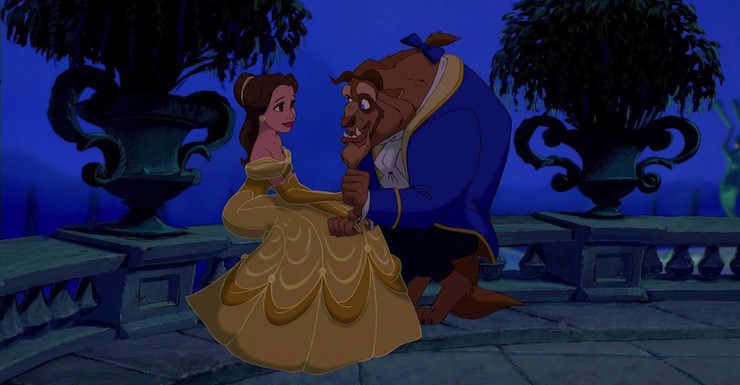As work began on Beauty and the Beast (1991), Disney animators were finally – finally – feeling confident again. Who Framed Roger Rabbit and The Little Mermaid had been critical and box office successes, and even The Rescuers Down Under, if not exactly a major hit, had at least allowed animators to work out computer animation techniques that they were eager to try on a new film. The animators were ready to return to the glory days of Disney animation, with a film that could be both a work of art and a box office success.
They succeeded beyond their wildest hopes.
Let’s get a few negative points out of the way. The film’s timeline does not make a lot of sense – it either takes place over an entire winter, or over a three day period. If the first, several internal elements make very little sense. For instance, how did poor LeFou survive standing outside Belle’s cottage, covered in snow, for several days? If the second, uh, how exactly did the countryside go from fall (the orange/red/yellow leaves at the beginning of the film) through winter (all that snow in the middle) through spring (the final scenes) in three days? I can only answer, fairy tale, and hope that’s enough.
(It was not enough for at least one exasperated six-year-old viewer.)
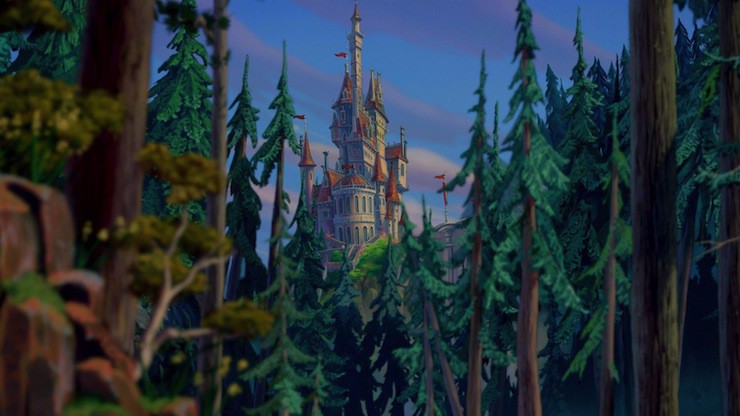
More seriously, yes, the climax of the film involves two men fighting over a woman. Yes, it has three characters called, sigh, the Bimbettes, or, in the stage version, the Silly Girls. Yes, one of the most famous sections involves a group of servants happily singing about how great it is to be back working for the aristocratic class again – this after they’ve spent most of the film enchanted thanks to the terrible temper of their aristocratic boss. And, of course, the film’s central message that “Beauty is found within” is sort of undercut when its one hideously ugly character is transformed into a outwardly handsome prince. And yes, this is a movie about a woman who falls for the guy that takes her prisoner. And yes, he really is a Beast and a jerk about it, yelling at her just because she, quite understandably, doesn’t want to have dinner with him under the circumstances, and… yeah, let’s hope this movie doesn’t take place over a three day period, because otherwise I’m kinda horrified.
I still love it.
A few possibly mitigating factors: for one, the Beast is a prisoner himself. While we’re on that topic, can we ask a few questions about what, exactly, was going on here? First, the not so small problem that the prince was answering his own doorbell – something not exactly standard at the time, and that’s before we learn that he has a small army of servants at that castle. Why didn’t one of the servants answer the door? Second, and more seriously, the decision by the enchantress to turn all of the human servants into living furniture, like, ok, so they didn’t do a great job of raising the prince up to be a nice guy, and yes, they clearly aren’t great at answering the door promptly, but this does seem to be a bit harsh. Especially since, as Disney executive Jeffrey Katzenberg revealed in later interviews, the prince was about ten at the time. Which is to say, fairy, you’re enchanting an entire castle just because a ten year old kid was rude to you? Have you considered some therapy for your slight—slight—overreaction to life? And third – given that this castle in some of the final scenes seems to be just a few hours march from the village, exactly how did all of this happen with apparently no one in the village aware that (a) a castle is there, and (b) it’s now enchanted? Or is that just part of the enchantment?
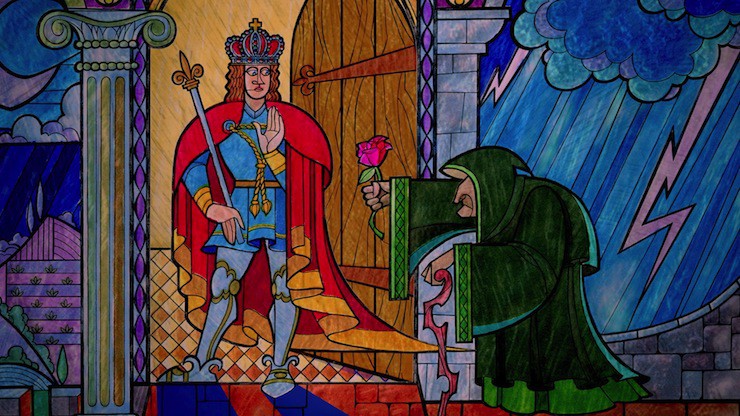
I suppose we could argue that the enchantress meant this only to be a learning experience, intending all along to set up a situation that would force Belle to the castle, where a chastened Beast would fall for her and vice versa, but if that was her plan—well, the Beast we originally meet isn’t chastened in the slightest. He’s angry. And although I don’t think he should be taking this anger out on Belle or her father, I do think that he has quite a few reasons to be angry—and to distrust anyone who happens to come knocking on his door.
After all, the last person who knocked on his door ended up both transforming him and linking his fate to a fragile, enchanted rose, for all intents and purposes imprisoning him in his own palace. The script makes that point explicit: his only connection to the world outside his castle is an enchanted mirror. The people who arrive after Belle are explicitly trying to kill him: they even sing about it. “KILL THE BEAST! KILL THE BEAST!” Under the circumstances I probably wouldn’t be too thrilled to see visitors either.
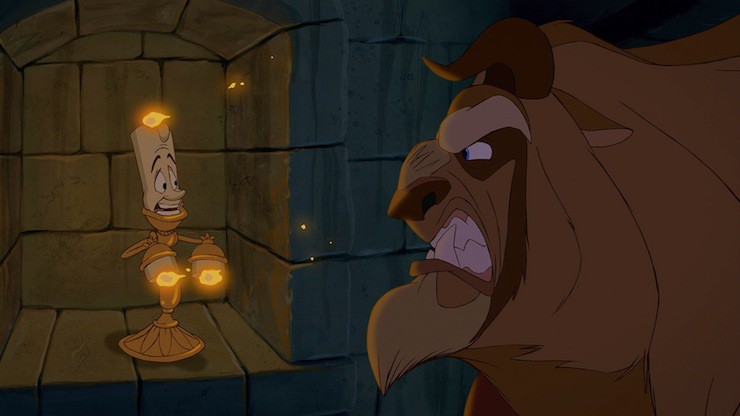
It’s also not surprising that all of this causes his temper to deteriorate still further. So quite apart from the “Who could ever learn to love a Beast?” question, we have a “Who could ever learn to love a Beast imprisoned in his own castle? A Beast so angry that he has ripped the once elegant furnishings of his room apart?” Indeed, if you ask me, the real villain of the film isn’t Gaston, who when not persecuting harmless crackpots and girls who want nothing to do with him and decorating his home with antlers, does round up the villagers to fight a dangerous beast, but rather the enchantress who PUT THE DANGEROUS BEAST NEAR THE VILLAGE IN THE FIRST PLACE.
Another mitigating factor: yes, the Beast takes Belle prisoner – but doesn’t lock her away. She is able to flee, and she returns on her own volition. Yes, this is partly because the Beast followed her and saved her life, and she feels a sense of gratitude – but even still; she had the opportunity to return to the village, and didn’t take it. Maybe she wanted to see all of those plates dancing again. And, of course, after their dance, he lets her go. Without, I might add, the conditions that bound Beauty in the literary versions, who must return within a certain time frame. The Beast simply lets her go, and then falls into a profound depression. Not once does he consider going after her, even though – since by this time the rose is nearly gone – it means his almost certain entrapment in a form that he hates.
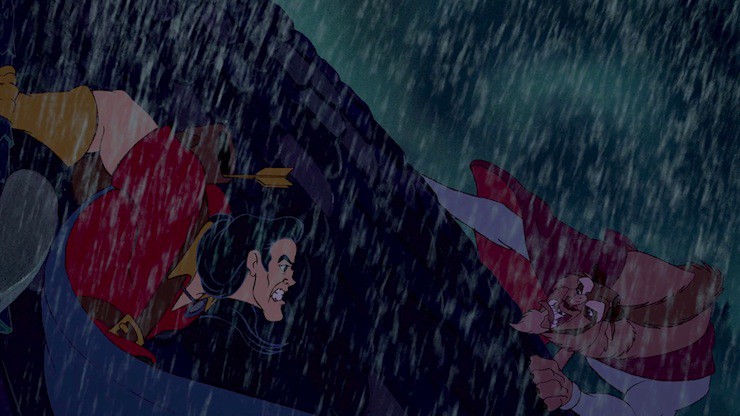
And a third mitigating factor: only one of the two men is really fighting about or over Belle in that last scene. The Beast is largely fighting in self-defense, and it takes a moment before he’s even willing to do that. His first reaction to the arrival of the villagers is to say “it doesn’t matter now,” which, GRATEFUL THANKS FROM ALL OF YOUR SERVANTS CURRENTLY UNDER ATTACK, BEAST, and if you’re going to be such a downer about that, how about AT LEAST coming down to the hall to give yourself up so your servants aren’t at (as much) risk, although it’s possible that that the freaked out villagers would have attacked the dancing furniture anyway, if only out of a hatred for Broadway musicals. I don’t know. In any case, Beast only really starts to fight back when he sees that Belle has returned, and all he demands is that Gaston leave his castle. Gaston is the one fighting over Belle, and Gaston has already been established as a villain.
And the way the whole transformation sequence kinda undercuts the “Beauty is found within” moral message? I’d argue it’s undercut well before that, because the guy running around terrorizing mostly harmless inventors who stumbled into his castle? Yeah. Not exactly gleaming with inner beauty no matter how understandable that anger is, changing the message of “Beauty is found within,” to “Beauty is found once you change your behavior patterns.”
The servants? Um. Hmm. Um. Oh, I know – that particular number allows them to do a little more dancing and singing and a little less manual labor, right, so that explains it?
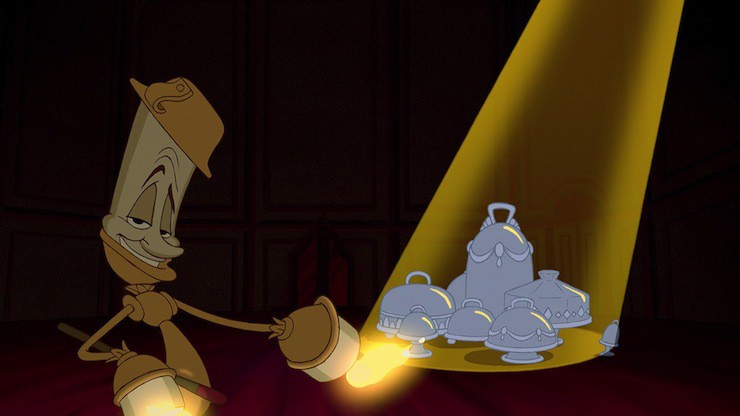
Maybe?
No?
Ok, so that one’s a bit difficult to explain away.
But the real mitigating factors are, of course, pretty much everything else in the film: the animation – Disney’s most beautiful work since Sleeping Beauty – the score, the songs, the tight, efficient script, and, can it be? Sacre bleu! Actual character development, for the first time in any Disney film since, well, Pinocchio? Granted, it’s just one character, but let’s take what we can get here.
What’s surprising about this is that all of this happened in a film developed and animated in a rush – Beauty and the Beast was scripted, storyboarded, and animated in less than two years, half the four year time period used for most Disney animated films.
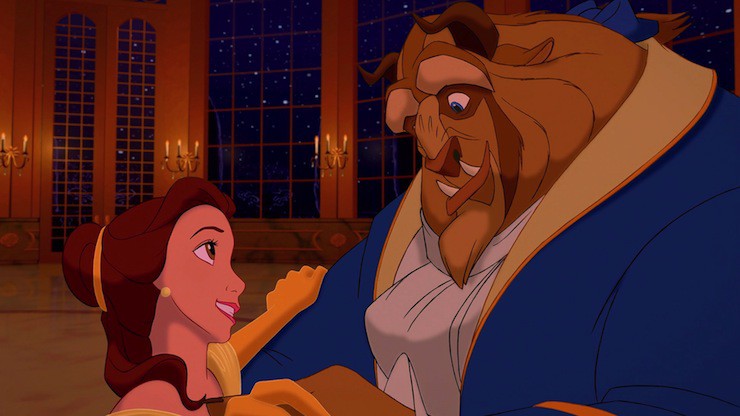
Most of that schedule was thanks to Jeffrey Katzenberg who, after watching the initial storyboards, threw the entire concept out, but refused to change the release date. Hearing this, the initial director understandably bowed out. Disney replaced him with Kirk Wise, who had joined Disney as an animator for The Great Mouse Detective, and Gary Trousdale, one of the very few people who started to work with Disney on The Black Cauldron and yet managed to have a relatively productive career with Disney afterwards. (Trousdale would eventually follow Katzenberg over to Dreamworks.)
The real direction and heart of the film, however, ended up coming from lyricist Howard Ashman, brought on with composer Alan Menken at Katzenberg’s insistence after their success with The Little Mermaid. Katzenberg wanted, not another non-musical adventure like The Rescuers Down Under, but another Broadway-style musical. Then dying of AIDS, Ashman poured his heart and soul into multiple aspects of the film: lyrics, story, characters, to the point where he neglected work on another film that he’d been hired to do (Aladdin.) Tragically, Ashman was to die eight months before the film was completed, although he was able to see bits of completed footage before he died.
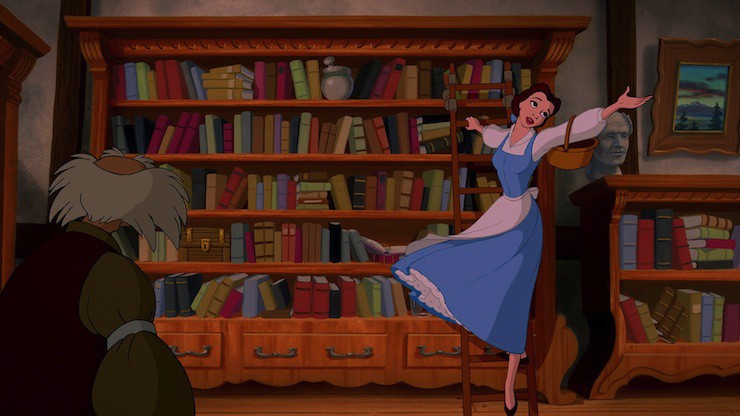
He was also able to hear recordings of his songs, which featured some of his best lyrical work, even if I still must confess a slight personal preference for “Poor Unfortunate Souls” over “Gaston.” “Belle,” for instance, serves not just as a grand, Broadway-style introduction to the film, Belle and Gaston, but also contains bits like “But behind that fair facade/I’m afraid she’s rather odd,” the first of many delightful rhymes. “Something There,” and “Mob Song,” work not just as songs, but also to advance the story. Indeed, “Something There,” is really not much of a song on its own, but within the film, it works to swiftly show us that these two characters are starting to see each other in a very different light – that something might be there.
The showstoppers, though, were the soon to become a Disney signature song, “Be Our Guest,” and the title song, “Beauty and the Beast,” which, according to legend, was recorded by Angela Lansbury in just one take. (Legend fails to say just how many stabs Celine Dion and Peabo Bryson did for the version that played over the end credits, the version released as a single.) Both also featured the use of Disney’s CAPS system, developed for The Rescuers Down Under, and here used to create a chorus line of dancing tableware and the illusion of a sweeping camera on a dolly for the ballroom scene with Belle and the Beast.
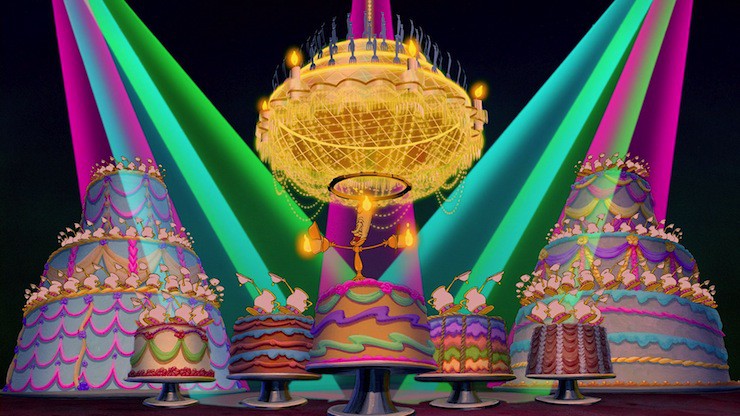
Disney later incorporated “Be Our Guest” into several different commercials for its various theme parks and cruise ships, eventually making it Disney’s second most used song, outdone only by “When You Wish Upon a Star.” As a ballad about a grumpy monster and a girl who loves to read, “Beauty and the Beast” was not quite as useful for luring tourists, but the Dion/Bryson cover was a commercial success, and added to the profits for the film.
The decision to create a Broadway style musical also influenced the casting. Disney did snag a few well known non-singing voices, including Robby Benson, then known largely as 70s teenage heartthrob, for the Beast, and David Ogden Stiers, then best known for his role as pompous Major Charles Emerson Winchester III on M.A.S.H., as pompous Cogsworth, the start of a long career as a Disney voice actor. Otherwise, the filmmakers focused on Broadway and musical theatre actors. To get a rich, vibrating, near operatic tone for Gaston even in mere conversation, for instance, they hired opera and Broadway singer Richard White.
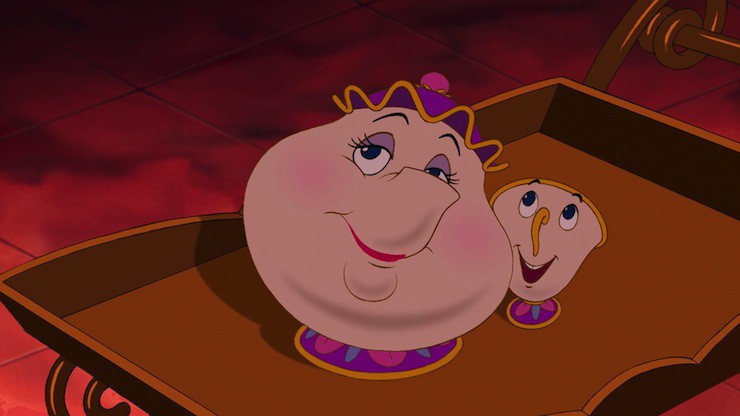
For Mrs. Potts, the producers snagged Angela Lansbury, then as now renowned not just for Murder, She Wrote, but also for her theatre and vocal work, and persuaded her to sing the film’s major ballad. Lansbury later called the role a gift to her three grandchildren. It also turned out to be a gift for Disney; the song – Lansbury’s version, not the tepid cover that plays over the credits – won an Academy Award, a Golden Globe Award and a Grammy. Jerry Orbach, another Broadway veteran, was brought in for Lumiere shortly before Law and Order took over the next 12 years of his life. For Belle, they hired Broadway singer Paige O’Hara, who infused a throbbing, emotional note into nearly every word.
That took care of vocal problems. The directors still, however, had to deal with the difficulties of attempting to animate the entire film in a shortened period – in two different locations on two different coastlines.
Pre-internet.
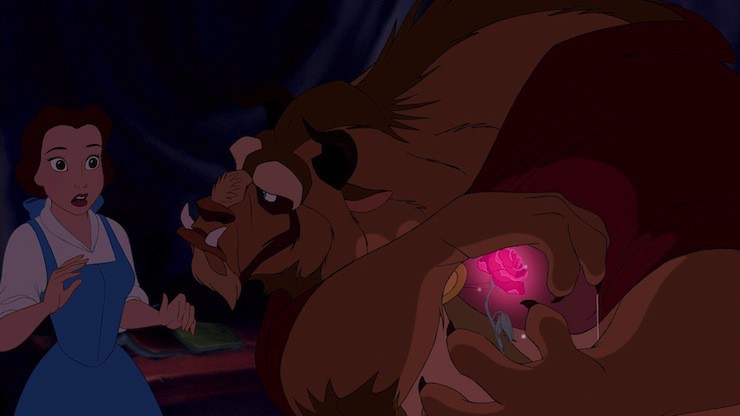
That particular problem was not the idea of anyone involved in the film, but rather of Disney executives, who wanted at least some of Beauty and the Beast animated at the smaller studio set up to allow tourists to watch animators at work, in what was then the Disney-MGM Studios theme park (now the Hollywood Studios theme park) in Florida. This proved particularly tricky during one of the most emotional scenes of the film, when Belle enters the West Wing and ends up having a fierce confrontation with the Beast. It was so emotional that the director ordered the voice actors to record their parts together, in contrast to most of the rest of the film, where Belle and Beast were recorded independently. When it came time to animate the scene, however, Glen Keane, drawing Beast in California, had to coordinate his work with Make Henn, drawing Belle for this particular scene in Florida. Keane would draw Beast, and then sort of scribble in a Belle, before sending off his drawings by overnight courier, and vice versa.
This is also why, if you pay attention, Belle does not always look precisely the same in all shots – she’s the work of different animators in different locations, and all of the overnight delivery systems in the world couldn’t compensate for those factors.
During all of this, both Howard Ashman and Jeffrey Katzenberg kept “suggesting” – read, ordering – changes to the story and script, forcing animators to tear up hours of drawings and start all over again. Katzenberg loved Chip, for instance, and demanded that the little teacup get a bigger role, but disliked the initial drawings for Gaston, the villain who uses antlers in all of his decorating, and who was, at least according to Katzenberg, not good-looking enough to drive home the point of looks versus character. Andreas Deja, who had started out at Disney in the uncomfortable position of working with Tim Burton’s very different artistic drawing style, now found himself in the only slightly more comfortable position of having to toss out his initial drawings and rework his initial concept – while under a tight deadline. Fortunately, as he admitted in later interviews, he had the examples of Hollywood actors with Gaston-like personalities to inspire him, making the “No one persecutes harmless crackpots like Gaston!” line completely credible.
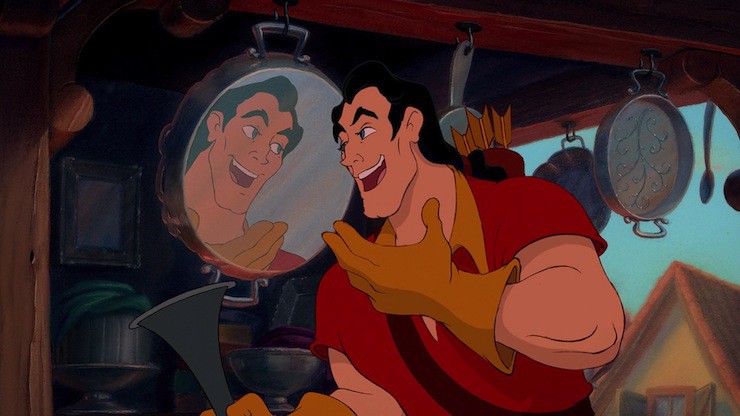
And, after decades of use, Disney’s multiplane camera, developed for Snow White, was mostly non-functional, suitable only for museum displays. (It’s appeared in various museum tours and at the Hollywood Studios theme park.) Here, once again, the CAPS system designed for The Rescuers Down Under saved the film, allowing animators to create the same multiplane effect for the now nearly ubiquitous camera-moving-through-the-trees shot that had opened so many of its films from Snow White onwards, but also using CAPS to simulate the movement of an aerial camera.
The other advantage of CAPS, of course – and the main reason Disney encouraged its use – was cheapness; the money saved there allowed Beauty and the Beast to feature several scenes with multiple animated figures. Three scenes feature more than thirty individually animated figures, something not seen from the studio in decades, though The Little Mermaid had come close. In some cases, this was computer trickery, as in “Be Our Guest,” which simply had the computer copy hundreds of images of candles, tankards, cutlery and whirling napkins. In other cases – the fight between the villagers and the castle furniture; the shot of Belle walking through dozens of squabbling villagers, and the chase scene with the wolves, these were individually animated figures.
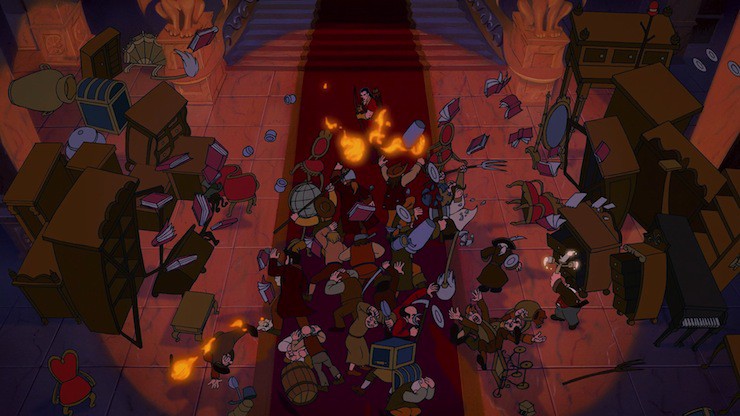
This had the side benefit of allowing animators to throw in a few background jokes here and there (watch the woman trying to fill her water jugs while Belle sings to the sheep about fairy tales), which along with comedic side characters like Cogsworth and LeFou, kept the film from getting too serious.
Which was fortunate, since at its center, Beauty and the Beast is a serious film, focused on two characters longing to escape. Like Ariel, Belle feels trapped in a world where she doesn’t feel she belongs. Unlike Ariel, Belle’s entrapment is more self-imposed, stemming from her love of her father and need to take care of him: there’s really nothing else (except, perhaps, a lack of money) keeping her in this provincial life, and although her father understandably tries to prevent her from becoming a prisoner of the Beast, he’s otherwise fully supportive of her. But Belle isn’t just looking for a different life: she’s looking for understanding. She’s looking for magic. She’s looking for a fairy tale – and falls in love with the Beast in part because, well, he is enchanted, and is in a fairy tale. At the same time, and to her credit, she’s quick to reject the fairy tale when her father needs her help – and equally quick to try to save the Beast when the villagers go after him.
And as much as the film might want to tell us – or more precisely, sing to us – that Belle falls for Beast after seeing “There’s something sweet/and almost kind” in the Beast, it seems more that these are two people who have fallen for each other in part out of mutual loneliness, in part because each recognizes that the other one wants something more than their current lives. Will a bookworm and a guy who apparently kept his huge library locked up behind heavy curtains be able to make it work? I don’t know, but if Belle decided to marry Beast for his library, I’m with her, and, after all, this is a fairy tale.
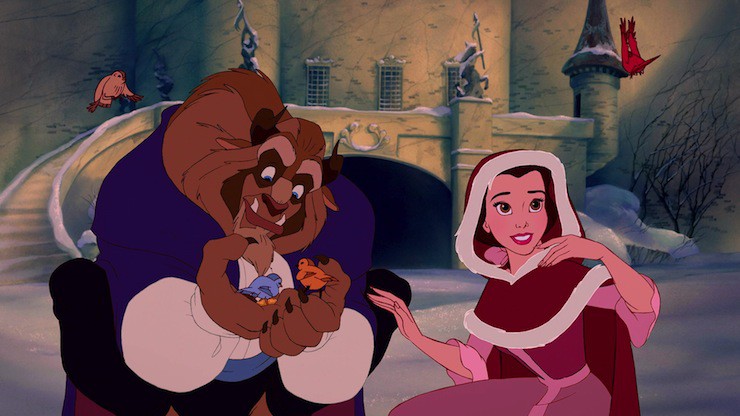
One quick note: some DVD editions of Beauty and the Beast include a five minute musical sequence, “Human Again,” added to the film. Written during early drafts of the film, and later replaced by “Something There,” “Human Again,” is not a terrible song, but the animation, done later, is not up to the original work, and interrupts the momentum of the film, not to mention the music, which is meant to go directly from “Something There” to the scene of Beast preparing for dinner – a scene that repeats the same melody. I couldn’t help thinking, with irritation, that the original team had removed this sequence for reason (they couldn’t fit it into the story) and should have focused on that reason.
The musical sequence also contains a small scene that irritates me more than it should: Belle, reading to Beast, asks him to read to her, and he confesses he can’t read, and she offers to teach him – starting with Romeo and Juliet. A, not exactly great beginner’s reading material there, Belle, and B, I don’t buy this: the Beast, at one point, was a prince, and if he has forgotten much of what he was taught (manners, using a knife and fork), much of that forgetting came from his transformation. Sure, the library was closed up until Belle arrived, but the same could be said for most of the castle.
Which is to say, if you can, try to watch the original edition.
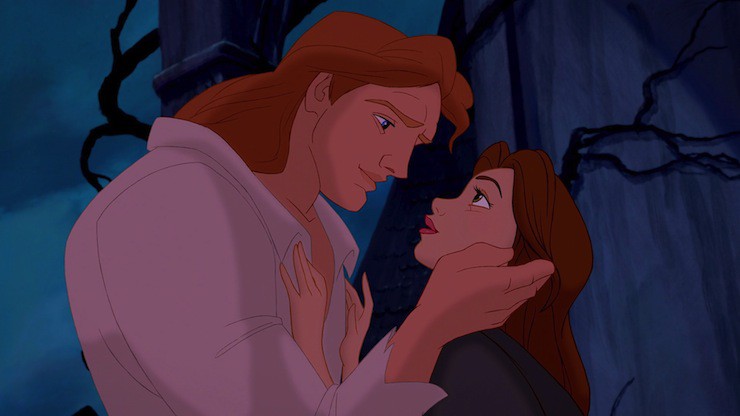
For Disney, at least, Beauty and the Beast had a very happy ending. The film was a box office and critical success, and became the first animated feature to be nominated for an Academy Award for Best Picture. (It lost to Silence of the Lambs, suggesting, not for the first time, that Academy voters were more interested in people eating each other than in people singing to each other.) It spawned two terrible direct to video sequels, Beauty and the Beast: The Enchanted Christmas and Beauty and the Beast: Belle’s Magical World, which at least made money, if not a positive artistic impression. The Christmas one is particularly terrible; if you haven’t seen it, continue to spare yourself. More positively, the film inspired a Broadway show and various attractions in nearly every Disney theme park, including stores, musical shows and, most recently, the Be Our Guest restaurant at Magic Kingdom. As one of the Disney Princesses, Belle makes regular appearances at the parks and Disney events, and has her own line of merchandise, including clothing, jewelry and housewares.
But above all, for Disney, Beauty and the Beast was a sign that The Little Mermaid had not just been a one-off fluke, a sign that its animators could produce popular, well reviewed entertainment that could even be viewed – by some critics – as high art. It was a sign that just maybe the studio could do more.
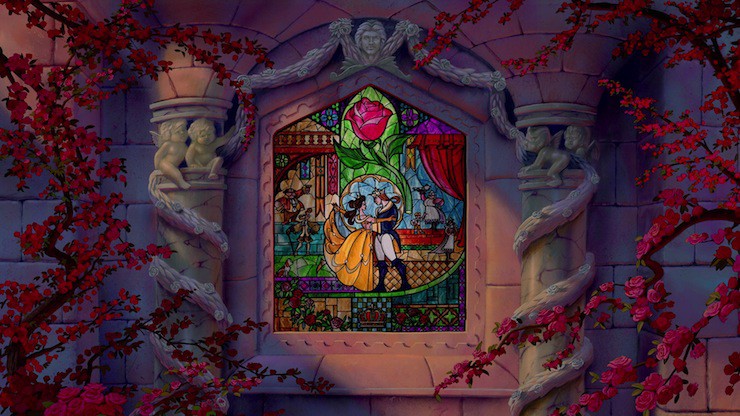
Disney CEO Michael Eisner saw the same signs, and was impressed enough by the profits from Beauty and the Beast that he ordered Jeffrey Katzenberg to keep the animation studio on its one film per year schedule, and approved plans for more ambitious animated films – films that could, for instance, look at U.S. history, or adapt major classics of French literature. The animators, excited, agreed to try.
But before the animators could really delve into those projects, they had one or two things to catch up with first. A small thing about a little lion cub – not much, really – and of course, this thing about a genie that Robin Williams had agreed to come on board for. Nothing close to Beauty and the Beast, of course, especially since Howard Ashman hadn’t been able to finish writing all of the lyrics for it, but still, it could be fun…
Aladdin, coming up next.
Mari Ness lives in central Florida.










